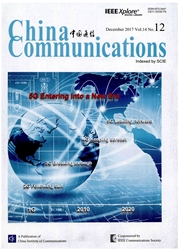

 中文摘要:
中文摘要:
Most existing algorithms for the underdetermined blind source separation(UBSS) problem are two-stage algorithm, i.e., mixing parameters estimation and sources estimation. In the mixing parameters estimation, the previously proposed traditional clustering algorithms are sensitive to the initializations of the mixing parameters. To reduce the sensitiveness to the initialization, we propose a new algorithm for the UBSS problem based on anechoic speech mixtures by employing the visual information, i.e., the interaural time difference(ITD) and the interaural level difference(ILD), as the initializations of the mixing parameters. In our algorithm, the video signals are utilized to estimate the distances between microphones and sources, and then the estimations of the ITD and ILD can be obtained. With the sparsity assumption in the time-frequency domain, the Gaussian potential function algorithm is utilized to estimate the mixing parameters by using the ITDs and ILDs as the initializations of the mixing parameters. And the time-frequency masking is used to recover the sources by evaluating the various ITDs and ILDs. Experimental results demonstrate the competitive performance of the proposed algorithm compared with the baseline algorithms.
 英文摘要:
英文摘要:
Most existing algorithms for the underdetermined blind source separation (UBSS) problem are two-stage algorithm, i.e., mixing parameters estimation and sources estimation. In the mixing parameters estimation, the previously proposed traditional clustering algorithms are sensitive to the initializations of the mixing parameters. To reduce the sensitiveness to the initialization, we propose a new algorithm for the UBSS problem based on anechoic speech mixtures by employing the visual information, i.e., the interaural time difference (ITD) and the interaural level difference (ILD), as the initializations of the mixing parameters. In our algorithm, the video signals are utilized to estimate the distances between microphones and sources, and then the estimations of the ITD and ILD can be obtained. With the sparsity assumption in the time-frequency domain, the Gaussian potential function algorithm is utilized to estimate the mixing parameters by using the ITDs and ILDs as the initializations of the mixing parameters. And the time-frequency masking is used to recover the sources by evaluating the various ITDs and ILDs. Experimental results demonstrate the competitive performance of the proposed algorithm compared with the baseline algorithms.
 同期刊论文项目
同期刊论文项目
 同项目期刊论文
同项目期刊论文
 Analysis Sparse Representation Based on Subset Pursuit and Weighted Split Bregman Iteration Algorith
Analysis Sparse Representation Based on Subset Pursuit and Weighted Split Bregman Iteration Algorith Human mouth-state recognition based on learned discriminative dictionary and sparse representation c
Human mouth-state recognition based on learned discriminative dictionary and sparse representation c Image encryption combining multiple generating sequences controlled fractional DCT with dependent sc
Image encryption combining multiple generating sequences controlled fractional DCT with dependent sc Image encryption scheme based on fractional Mellin transform and phase retrieval technique in fracti
Image encryption scheme based on fractional Mellin transform and phase retrieval technique in fracti Color imageencryption combining a reality-preserving fractional DCT with chaotic mappingin HSI space
Color imageencryption combining a reality-preserving fractional DCT with chaotic mappingin HSI space 期刊信息
期刊信息
